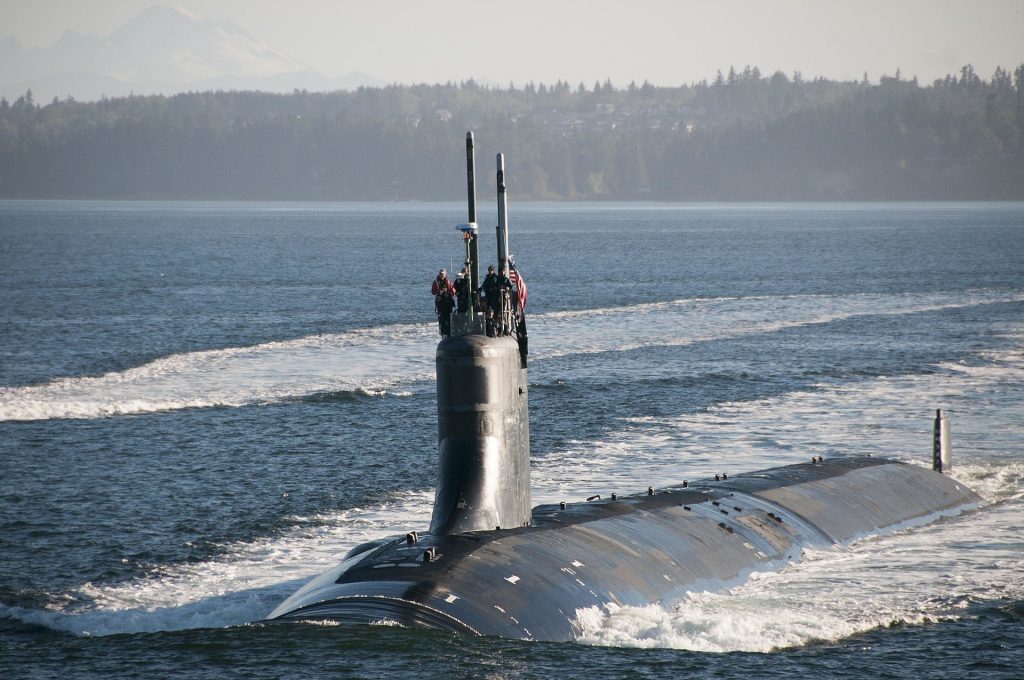
The Seawolf-class nuclear-powered fast attack submarines (SSN) are currently in service with the United States Navy. The class was originally intended to succeed the 688 Los Angeles-class attack boats, and design work began on it in 1983. A fleet of 29 submarines was planned to be built over ten years, but that was subsequently reduced to just 12 submarines. However, the end of the Cold War and budget constraints dictated the cancellation of any further additions to the fleet in 1995. Accordingly, the entire Seawolf-class was limited to just three boats that include the USS Seawolf SSN-21, USS Connecticut SSN-22 and USS Jimmy Carter SSN-23. This in turn, led to the design of the smaller and less expensive SSN-774 Virginia-class attack submarines. The Seawolf-class cost about $3 billion per unit making it the most expensive U.S built, SSN submarine and second most expensive submarine ever, after the French SSBN Triumphant-class.

The Seawolves were envisioned as the finest submarines ever to be built and were designed to succeed the 688 class to maintain America’s edge in the underwater warfare and reconnaissance realm. And although the class eventually became doomed, they are still some of the most technologically advanced and sophisticated submarines ever constructed, nevertheless, they were built in reduced numbers. Thus, their story is comparable to that of the F-22 fighter jet; widely considered the world’s best, but high costs and unforeseen geopolitical conditions rendered them obsolete before their time.
The Seawolf design was intended to combat the threat of advanced Soviet ballistic missile submarines such as the Typhoon-class, and attack submarines such as the Akula-class in a deep-ocean environment so their pressure hulls are constructed using HY-100 steel, which is stronger than the HY-80 steel employed in previous classes, to withstand increased sea pressure at greater depths.
Seawolf submarines are larger, faster, and significantly quieter than their predecessor Los Angeles-class submarines, carry a larger weapons load, and have twice as many torpedo tubes. Additionally, the boats can carry up to 50 UGM-109 Tomahawk cruise missiles for attacking land and sea surface targets. The boats also have extensive advanced equipment to permit shallow water operations and they utilize the more cutting-edge ARCI Modified AN/BSY-2 combat system, which includes a larger spherical sonar array, a wide aperture array (WAA), and a new towed-array sonar. The BSY-2 is a fully integrated system used for sonar tracking, monitoring, and launch of all on-board weapons, including Mk 48 ADCAP/ADCAP MOD torpedoes, Tomahawk missiles, and mines. Each submarine is powered by a single S6W nuclear reactor, delivering 45,000 hp (34 MW) to a low-noise pump jet.
As a result of their advanced design, however, Seawolf submarines were considerably more expensive than their earlier counterparts. The projected cost for 12 submarines of this class was $33.6 billion, however, construction ceased at three boats when the Cold War ended.
In the late 1980s, the U.S. Navy had been confronted with a crisis because the Soviet Union had received information from the Walker family spy ring that the Navy could track its submarines through excessive propeller noise, or cavitation. As a result, the Soviet Union sought advanced Western machinery to make higher quality and quieter submarine props. Consequently, in 1981, the Japanese company Toshiba sold propeller milling machinery, which now is a relatively common nine-axis CNC milling machine, to the Soviet Union via the Norwegian Kongsberg Corporation. Subsequently, by the mid-1980s, the Soviet Union’s more advanced prop milling machinery began to make its presence felt with new Akula-class submarines exhibiting a “steep drop in broadband acoustic noise profiles” rendering them more difficult to pick up on USN Sonars. One government source told the Los Angeles Times, “the submarines started to get stealthier only after the Toshiba stuff went in.” On top of running more quietly, the Akula class could dive to depths of up to two thousand feet while the U.S. Navy’s frontline submarines, the Los Angeles class were limited to only 1480 feet.
So, to combat the growing threat of the Soviet Akula-class boats, the U.S. Navy responded with the Seawolf-class of nuclear attack submarines. And it built them with HY-100 steel alloy hulls two inches thick to better withstand the pressures of deep submergence and that are roughly 20 percent stronger than the HY-80 product used in the Los Angeles class boats. As a result, the submarines are capable of diving to depths of up to two thousand feet, and their designed collapse depth (crush depth) estimates run from 2,400 to 3,000 feet. Too, at 353 feet long, Seawolf subs are designed to be slightly shorter than their predecessors, by just seven feet, but with a twenty percent wider beam, making them forty feet wide. This additional width renders them substantially heavier than the prior submarines topping the scales at 12,158 tons submerged.
The three Seawolf submarines are each powered by one Westinghouse S6W nuclear reactor, driving two steam turbines to a total of 52,000 shaft horsepower, and the class was the first of American submarines to utilize pump-jet propulsors over traditional propellers, a feature that has carried over to the newest Virginia-class. A pump-jet works by having an intake, usually at the bottom of the hull, which allows water to pass underneath the vessel into the engines. When the water enters the pump through this inlet the water pressure inside the inlet is increased by the pump and forced backward through a nozzle creating thrust. It’s very similar to the workings of a jet engine. As a result, a Seawolf is capable of achieving speeds of eighteen knots on the surface, a maximum of 35 knots underwater, and a silent running speed of about 20 knots.
The boats are equipped with the BQQ 5D sonar system, which features a twenty-four-foot-diameter bow-mounted spherical active and passive array as well as wide-aperture passive flank arrays. And, the submarines are being refitted with TB-29A thin-line towed array sonar systems. Rounding out sonar systems is the BQS 24, for detection of close-range objects such as mines.
The ship’s original combat data system was the Lockheed Martin BSY-2, which uses a network of seventy Motorola 68030 processors, the same processor that drove early Macintosh computers but is now being replaced with the AN/BYG-1 Weapons Control System. AN/BYG-1 is an open-architecture submarine combat control system for analyzing and tracking submarine and surface ship contacts, providing situational awareness, as well as the capability to target and employ torpedoes and missiles.
The submarines were designed to be true hunters of the deep having eight torpedo tubes, double the number of earlier submarines. It has weapons storage for a combination of up to fifty Mark 48 heavyweight torpedoes, Sub-Harpoon anti-ship missiles, and Tomahawk missiles. Alternatively, it can substitute some of this ordnance for mines. And the subs, according to the U.S. Navy, are ten times quieter over the full range of operating speeds than the improved Los Angeles submarines, and an astonishing seventy times quieter than the original Los Angeles-class submarines and can run quietly at twice the speed of previous boats.
This formidable increase in performance came at a daunting increase in cost as well resulting in the total Seawolf program having been estimated at $33 billion for twelve submarines, an unacceptable cost considering the Soviet Union along with the threat of the Akula and follow-on subs ended in 1991. Subsequently, the program was trimmed to just three submarines that cost $7.3 billion combined.
The extreme quietness of the Seawolf-class encouraged the Navy to modify the last submarine of the class, USS Jimmy Carter SSN-23, to provide support for clandestine operations. Accordingly, an extension of one hundred feet was added to the hull, a section known as the Multi-Mission Platform (MMP). The MMP gives Carter the ability to send and recover Remotely Operated Vehicles/Unmanned Underwater Vehicles and SEAL diving teams while submerged. It includes berthing for up to fifty SEALs or other attached special personnel. Carter also features auxiliary maneuvering devices fore and aft for precise maneuvering in situations such as undersea cable tapping and other acts of espionage. This role was formerly filled by the now-decommissioned USS Parche SSN-683 that was in service for most of the last half of the Cold War. Jimmy Carter was modified for this role by General Dynamics Electric Boat at a cost of $887 million.
The Seawolf-class submarines are outstanding, but the Cold War mindset at the time of development accepted high performance and consequently high costs to meet a high-level threat. However, the post–Cold war period forced the Navy to rein in costs while still producing progressively better Virginia- Class submarines. Although unsuccessful as a class, the tiny Seawolf fleet is still a very useful part of the U.S. Navy submarine force, giving its capabilities the Virginia-class can match.
